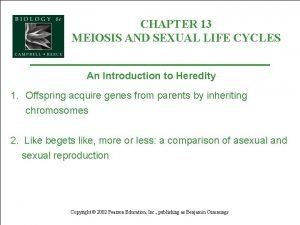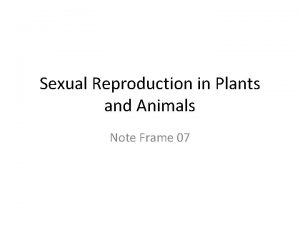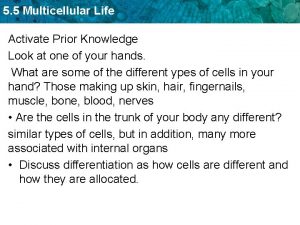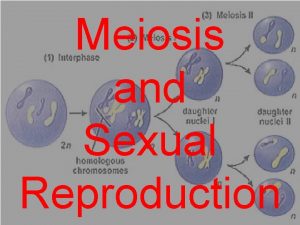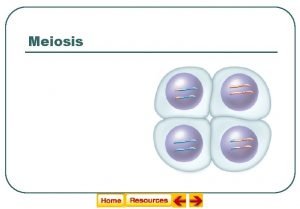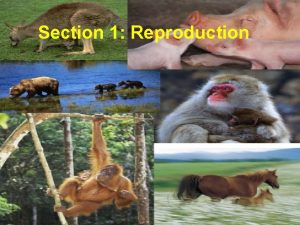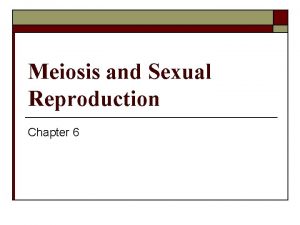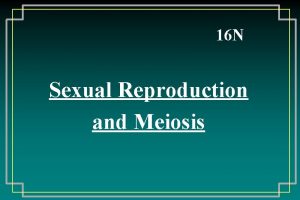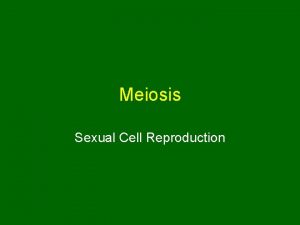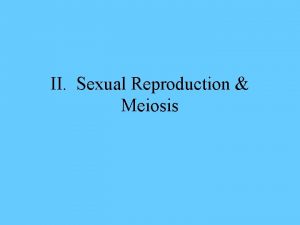Meiosis and Sexual Reproduction Section 3 Multicellular Life


















- Slides: 18

Meiosis and Sexual Reproduction Section 3: Multicellular Life Cycles Preview • Bellringer • Key Ideas • Diploid Life Cycle • Haploid Life Cycle • Alternation of Generations • Summary Section 3

Meiosis and Sexual Reproduction Section 3 Bellringer Write a sentence using each one of the following terms: haploid, diploid, zygote.

Meiosis and Sexual Reproduction Key Ideas • What is a diploid life cycle? • What is a haploid life cycle? • What is alternation of generations? Section 3

Meiosis and Sexual Reproduction Section 3 Diploid Life Cycle • Most animals have a diploid life cycle. • Most of the life cycle is spent in the diploid state. • All of the cells except the gametes are diploid. • A diploid germ cell in a reproductive organ goes through meiosis and forms gametes.

Meiosis and Sexual Reproduction Section 3 Diploid Life Cycle, continued • The gametes, the sperm and the egg, join during fertilization. The result is a diploid zygote. • This single diploid cell goes through mitosis and eventually gives rise to all of the cells of the adult, which are also diploid. • In diploid life cycles, meiosis in germ cells of a multicellular diploid organism results in the formation of haploid gametes.

Meiosis and Sexual Reproduction Diploid Life Cycle Section 3

Meiosis and Sexual Reproduction Section 3 Diploid Life Cycle, continued Meiosis and Gamete Formation • Male animals produce gametes called sperm. • A diploid germ cell goes through meiosis I. Two cells are formed, each of which goes through meiosis II. • The result is four haploid cells. • The four cells change in form and develop a tail to form four sperm.

Meiosis and Sexual Reproduction Section 3 Visual Concept: Formation of Sperm Click above to play the video.

Meiosis and Sexual Reproduction Section 3 Diploid Life Cycle, continued Meiosis and Gamete Formation • Female animals produce gametes called eggs, or ova (singular, ovum). • A diploid germ cell begins to divide by meiosis. Meiosis I results in the formation of two haploid cells that have unequal amounts of cytoplasm. • One of the cells has nearly all of the cytoplasm. The other cell, called a polar body, is very small and has a small amount of cytoplasm.

Meiosis and Sexual Reproduction Section 3 Diploid Life Cycle, continued Meiosis and Gamete Formation • The polar body may divide again, but its offspring cells will not survive. • The larger cell goes through meiosis II, and the division of the cell’s cytoplasm is again unequal. • The larger cell develops into an ovum. The smaller cell, the second polar body, dies.

Meiosis and Sexual Reproduction Section 3 Diploid Life Cycle, continued Meiosis and Gamete Formation • Because of its larger share of cytoplasm, the mature ovum has a rich storehouse of nutrients. • These nutrients nourish the young organism that develops if the ovum is fertilized.

Meiosis and Sexual Reproduction Section 3 Visual Concept: Formation of the Egg Cell Click above to play the video.

Meiosis and Sexual Reproduction Section 3 Haploid Life Cycle • The haploid life cycle happens in most fungi and some protists. • Haploid stages make up the major part of this life cycle. • The zygote, the only diploid structure, goes through meiosis immediately after it is formed and makes new haploid cells.

Meiosis and Sexual Reproduction Section 3 Haploid Life Cycle, continued • The haploid cells divide by mitosis and give rise to multicellular haploid individuals. • In haploid life cycles, meiosis in a diploid zygote results in the formation of the first cell of a multicellular haploid individual.

Meiosis and Sexual Reproduction Section 3 Alternation of Generations • Plants and most multicellular protists have a life cycle that alternates between a haploid phase and a diploid phase called alternation of generations. • In plants, the multicellular diploid phase in the life cycle is called a sporophyte. • Spore-forming cells in the sporophyte undergo meiosis and produce spores.

Meiosis and Sexual Reproduction Section 3 Alternation of Generations, continued • A spore forms a multicellular gametophyte. • The gametophyte is the haploid phase that produces gametes by mitosis. • The gametes fuse and give rise to the diploid phase.

Meiosis and Sexual Reproduction Visual Concept: Alternation of Generations Section 3

Meiosis and Sexual Reproduction Section 3 Summary • In diploid life cycles, meiosis in germ cells of a multicellular diploid organism results in the formation of haploid gametes. • In haploid life cycles, meiosis in a diploid zygote results in the formation of the first cell of a multicellular haploid individual. • Plants and most multicellular protists have a life cycle that alternates between a haploid phase and a diploid phase called alternation of generations.
 Sexual reproduction and genetics section 1 meiosis
Sexual reproduction and genetics section 1 meiosis Chapter 10 section 3 gene linkage and polyploidy
Chapter 10 section 3 gene linkage and polyploidy Asexualk
Asexualk The disadvantages of sexual reproduction
The disadvantages of sexual reproduction Venn diagram of sexual and asexual reproduction in animals
Venn diagram of sexual and asexual reproduction in animals Metaphase ii
Metaphase ii Chapter 13 meiosis and sexual life cycles
Chapter 13 meiosis and sexual life cycles Mendelian genetics
Mendelian genetics Difference of sexual and asexual reproduction
Difference of sexual and asexual reproduction Animal chromosome number
Animal chromosome number Sexual and asexual reproduction in animals venn diagram
Sexual and asexual reproduction in animals venn diagram Chapter 10 sexual reproduction and genetics
Chapter 10 sexual reproduction and genetics Asexual reproduction cell division
Asexual reproduction cell division Example sexual reproduction
Example sexual reproduction Where does cactus store water
Where does cactus store water Budding asexual reproduction
Budding asexual reproduction Example of budding
Example of budding Section 17-3 evolution of multicellular life answer key
Section 17-3 evolution of multicellular life answer key Section 17-3 evolution of multicellular life answer key
Section 17-3 evolution of multicellular life answer key






